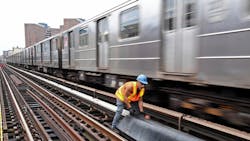MTA issues final after-action report following success of Subway Action Plan
The final after-action report for the Subway Action Plan (SAP) has been released by the Metropolitan Transportation Authority (MTA).
The plan was a comprehensive $836-million initiative first implemented in 2017 to stabilize the subway system and create a modern management plan based on lessons learned to elevate the operations and performance of the entire system.
“The Subway Action Plan helped us identify both quick fixes and long-term solutions that are now resulting in sustained improvements in subway service. We thank the governor for his support and his laser focus to ensure that the state’s investments realize tangible results for our customers,” said MTA Chairman and CEO Patrick J. Foye. “The system has shown continued improvements thanks to these changes, and we will keep pushing ourselves onward because we know that we have more to do”.
SAP implemented several initiatives to stabilize the subway system, which MTA says was suffering from a troubling number of disruptive incidents that had a clear impact on customers. New York Gov. Andrew Cuomo declared a state of emergency, clearing the path for accelerated emergency measures to immediately arrest further decline of subway service and reliability. Phase One of SAP sought to stabilize the system, and Phase Two focused on developing and institutionalizing the successes from Phase One work to establish a long-term focus on the system modernization, improvements and sustain SAP progress.
The SAP initiatives include power disruption mitigation programs in collaboration with the New York State Public Service Commission and Con Edison; accelerated fleet maintenance and inspections; accelerated installation of continuous welded rail (CWR) and rail grinding; whole-network cleaning of underground tracks; deep station cleaning; full system inspection of all signals and proactive repairs; widespread water mitigation efforts such as grouting, leak repairs, street grate clearing and drain cleaning; faster incident response times; and an intense focus on elevator and escalator maintenance that prioritizes proactive repairs.
These worked concurrently with New York City Transit (NYCT) campaigns such as a back-to-basic approach to service management and Save Safe Seconds efforts to increase speeds, which included the SPEED (Subway Performance Evaluation, Education and Development) unit to identify and fix mis-calibrated signal timers, encouraging employees to look for opportunities to improve service and the Group Station Manager program.
Following the state and the city’s initial investment of $836 million to implement SAP, the MTA will invest more than $300 million per year to NYCT’s operating budget to support SAP initiatives and to ensure that its success and progress are sustained.
SAP final actions and the SAP final after-action report are available on the MTA’s website.
